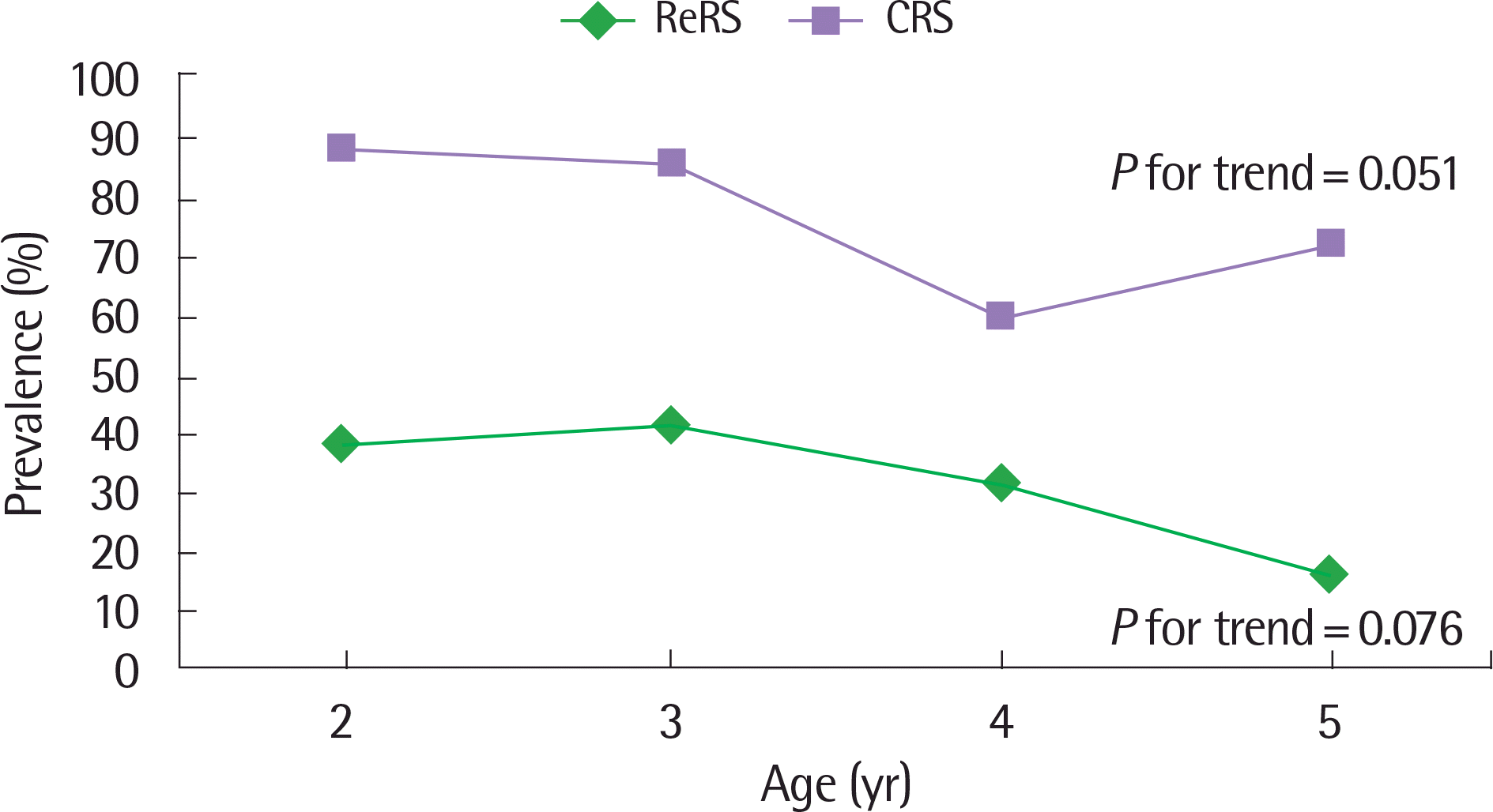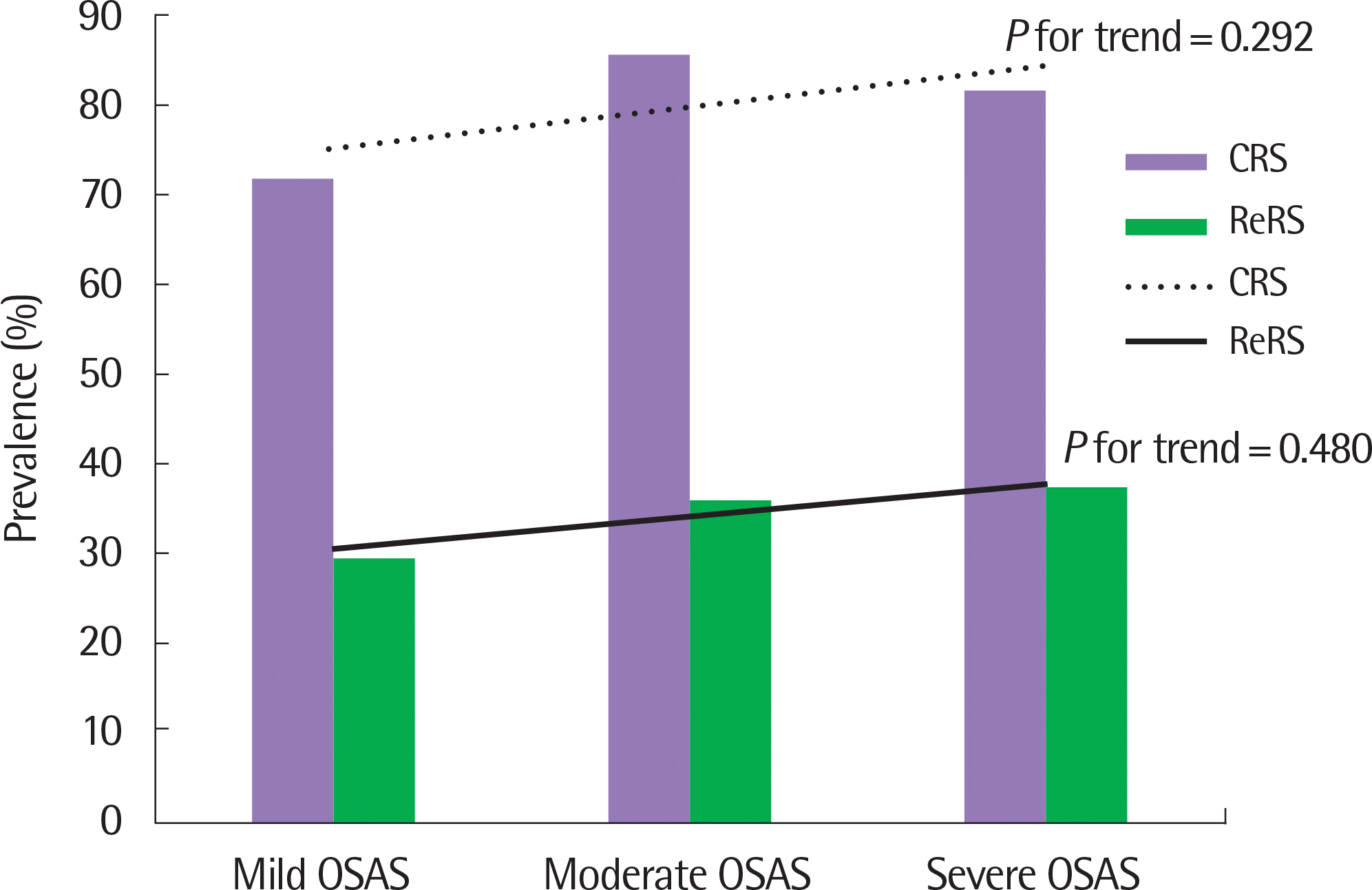Abstract
Purpose
Obstructive sleep apnea syndrome (OSAS) in young children is frequently caused by adenoid and/or tonsillar hypertrophy. Adenoidectomy is the first operative method for childhood chronic rhinosinusitis (CRS). We investigated factors associated with recurrent rhinosinusitis in preschool aged children with OSAS to determine the association of 2 common diseases.
Methods
One hundred forty-six children aged 2–5 years who were diagnosed as having OSAS after polysomnography between December 2003 and April 2016 were enrolled in this study. Children were divided into 2 groups with and without CRS. The 2 groups were compared in the severity of OSAS and allergy diseases and were evaluated for recurrent rhinosinusitis during the follow-up period, 1 year after diagnosis.
Results
Among 108 patients with OSAS who were followed up, 81 patients (75%) were diagnosed with CRS. There were no significant difference clinical and allergic characteristics between groups with and without CRS. However, bronchial asthma and otitis media was significantly more prevalent in patients with CRS than in those without (P=0.045 and P=0.000, respectively). Bronchial asthma and adenotonsillectomy was significantly associated with recurrent rhinosinusitis (P=0.005 and P=0.04, respectively) during the 1-year follow-up.
Conclusion
Approximately 75% of preschool children with OSAS have suffered from CRS. Bronchial asthma is associated with CRS among OSAS children. Recurrent rhinosinusitis is decreased after adenotonsillectomy, and bronchial asthma is an associated factor for recurrent rhinosinusitis after a follow-up. This close relationship childhood OSAS and recurrent rhinosinusitis/bronchial asthma needs further studies to investigate their role in the association.
REFERENCES
1. Castronovo V, Zucconi M, Nosetti L, Marazzini C, Hensley M, Veglia F, et al. Prevalence of habitual snoring and sleep-disordered breathing in preschool-aged children in an Italian community. J Pediatr. 2003; 142:377–82.

2. Marcus CL, Brooks LJ, Draper KA, Gozal D, Halbower AC, Jones J, et al. Diagnosis and management of childhood obstructive sleep apnea syndrome. Pediatrics. 2012; 130:e714–55.

3. Choi SH, Han MY, Ahn YM, Park YM, Kim CK, Kim HH, et al. Predis-posing factors associated with chronic and recurrent rhinosinusitis in childhood. Allergy Asthma Immunol Res. 2012; 4:80–4.

4. Gozal D, Kheirandish-Gozal L. New approaches to the diagnosis of sleep-disordered breathing in children. Sleep Med. 2010; 11:708–13.

5. Deniz M, Gultekin E, Ciftci Z, Alp R, Ozdemir DN, Isik A, et al. Nasal mucociliary clearance in obstructive sleep apnea syndrome patients. Am J Rhinol Allergy. 2014; 28:178–80.

6. American Academy of Sleep Medicine. The AASM manual for the scoring of sleep and associated events: rules, terminology and technical speci-fications. 2nd ed.Westchester (IL): American Academy of Sleep Medicine;2012.
7. Slavin RG, Spector SL, Bernstein IL, Kaliner MA, Kennedy DW, Virant FS, et al. The diagnosis and management of sinusitis: a practice parameter update. J Allergy Clin Immunol. 2005; 116(6 Suppl):S13–47.

8. Chandran SK, Higgins TS. Chapter 5: Pediatric rhinosinusitis: definitions, diagnosis and management–an overview. Am J Rhinol Allergy. 2013; 27(Suppl 1):S16–9.
9. Pedersen SE, Hurd SS, Lemanske RF Jr, Becker A, Zar HJ, Sly PD, et al. Global strategy for the diagnosis and management of asthma in children 5 years and younger. Pediatr Pulmonol. 2011; 46:1–17.

10. Arens R, Sin S, Willen S, Bent J, Parikh SR, Freeman K, et al. Rhino-sinus involvement in children with obstructive sleep apnea syndrome. Pediatr Pulmonol. 2010; 45:993–8.

11. Kirk V, Baughn J, D'Andrea L, Friedman N, Galion A, Garetz S, et al. American academy of sleep medicine position paper for the use of a home sleep apnea test for the diagnosis of OSA in children. J Clin Sleep Med. 2017; 13:1199–203.

12. Aitken M, Taylor JA. Prevalence of clinical sinusitis in young children followed up by primary care pediatricians. Arch Pediatr Adolesc Med. 1998; 152:244–8.

13. Huang SW, Giannoni C. The risk of adenoid hypertrophy in children with allergic rhinitis. Ann Allergy Asthma Immunol. 2087; 350–5.

14. Kohler MJ, van den Heuvel CJ. Is there a clear link between overweight/obesity and sleep disordered breathing in children? Sleep Med Rev. 2008; 12:347–61.

15. Bonuck KA, Freeman K, Henderson J. Growth and growth biomarker changes after adenotonsillectomy: systematic review and metaanalysis. Arch Dis Child. 2009; 94:83–91.

16. Suzuki M, Watanabe T, Mogi G. Clinical, bacteriological, and histological study of adenoids in children. Am J Otolaryngol. 1999; 20:85–90.

17. Lombardi E, Stein RT, Wright AL, Morgan WJ, Martinez FD. The relation between physician-diagnosed sinusitis, asthma, and skin test reactivity to allergens in 8-year-old children. Pediatr Pulmonol. 1996; 22:141–6.

18. Gutman M, Torres A, Keen KJ, Houser SM. Prevalence of allergy in patients with chronic rhinosinusitis. Otolaryngol Head Neck Surg. 2004; 130:545–52.

19. Berrettini S, Carabelli A, Sellari-Franceschini S, Bruschini L, Abruzzese A, Quartieri F, et al. Perennial allergic rhinitis and chronic sinusitis: correlation with rhinologic risk factors Allergy. 1999; 54:242–8.
20. Kim EJ, Kwon JW, Lim YM, Yoon D, Seo JH, Chang WS, et al. Assessment of total/specific IgE levels against 7 inhalant allergens in children aged 3 to 6 years in Seoul, Korea. Allergy Asthma Immunol Res. 2013; 5:162–9.

21. Huang SW. The risk of sinusitis in children with allergic rhinitis. Allergy Asthma Proc. 2000; 21:85–8.

22. Leo G, Piacentini E, Incorvaia C, Consonni D, Frati F. Chronic sinusitis and atopy: a cross-sectional study. Eur Ann Allergy Clin Immunol. 2006; 38:361–3.
23. Tuncer U, Aydogan B, Soylu L, Simsek M, Akcali C, Kucukcan A. Chronic rhinosinusitis and adenoid hypertrophy in children. Am J Otolaryngol. 2004; 25:5–10.

24. Kao LT, Hung SH, Lin HC, Liu CK, Huang HM, Wu CS. Obstructive sleep apnea and the subsequent risk of chronic rhinosinusitis: a population-based study. Sci Rep. 2016; 10(6):20786.

25. Prasad B, Nyenhuis SM, Weaver TE. Obstructive sleep apnea and asthma: associations and treatment implications. Sleep Med Rev. 2014; 18:165–71.

26. Bhattacharjee R, Kheirandish-Gozal L, Spruyt K, Mitchell RB, Promchi-arak J, Simakajornboon N, et al. Adenotonsillectomy outcomes in treatment of obstructive sleep apnea in children: a multicenter retrospective study. Am J Respir Crit Care Med. 2010; 182:676–83.
27. Anfuso A, Ramadan H, Terrell A, Demirdag Y, Walton C, Skoner DP, et al. Sinus and adenoid inflammation in children with chronic rhinosinusitis and asthma. Ann Allergy Asthma Immunol. 2015; 114:103–10.

28. Ponikau JU, Sherris DA, Kephart GM, Kern EB, Gaffey TA, Tarara JE, et al. Features of airway remodeling and eosinophilic inflammation in chronic rhinosinusitis: is the histopathology similar to asthma? J Allergy Clin Immunol. 2003; 112:877–82.
29. Jiang RS, Liang KL, Hsin CH, Su MC. The impact of chronic rhinosinusitis on sleep-disordered breathing. Rhinology. 2016; 54:75–9.

30. Gozal D, Serpero LD, Sans Capdevila O, Kheirandish-Gozal L. Systemic inflammation in non-obese children with obstructive sleep apnea. Sleep Med. 2008; 9:254–9.

31. Huo Z, Shi J, Shu Y, Xiang M, Lu J, Wu H. The relationship between allergic status and adenotonsillar regrowth: a retrospective research on children after adenotonsillectomy. Sci Rep. 2017; 7:46615.

32. Meng W, Zhou W, Li G, Zhagn Q, Li G, Zhou H, et al. The analysis of surgery effect of OSAHS children accompanied with sinusitis. Lin Chung Er Bi Yan Hou Tou Jing Wai Ke Za Zhi. 2014; 28:462–4.
Fig. 1.
Linear-by-linear association of chronic rhinosinusitis and recurrent rhinosinusitis in obstructive sleep apnea syndrome according to age. Linear-by-linear association test indicates the prevalence of chronic rhinosinusitis and recurrent rhinosinusitis decreases not significantly as age increases (P for trend=0.051 and P for trend=0.076, respectively). ReRS, recurrent rhinosinusitis; CRS, chronic rhinosinusitis and recurrent rhinosinusitis. Trend in proportions assessed with Linear-by-linear association test.

Fig. 2.
The proportion of chronic rhinosinusitis and recurrent rhinosinusitis in obstructive sleep apnea syndrome by obstructive sleep apnea syndrome severity. The proportion of chronic rhinosinusitis and recurrent rhinosinusitis in obstructive sleep apnea syndrome was not significantly rising trend with increasing obstructive sleep apnea syndrome severity (P for trend=0.292 and P for trend=0.480, respectively). CRS, chronic rhinosinusitis and recurrent rhinosinusitis; ReRS, recurrent rhinosinusitis; OSAS, obstructive sleep apnea syndrome. Trend in proportions assessed with Linear-by-linear association test.

Table 1.
Clinical characteristics of children with and without CRS




 PDF
PDF ePub
ePub Citation
Citation Print
Print


 XML Download
XML Download